Using thyroid hormone the “right way” is just as important as using the right type of thyroid supplement or medication.
For example… Not too long ago I began working with a new client and we got on the topic of thyroid medication.
As we talked about what she was using and how she was using it, it brought up some very important points.
Points that you really need to understand and that can greatly benefit you too.
The truth is that you are most likely using the wrong thyroid medication or supplement for you, which we covered in detail in a previous post on Thyroid Medication (the Good, the Bad, and the Ugly).
Or…
maybe you’re using the right medication or supplement but in a completely wrong way. As my client can tell you firsthand, using thyroid hormone the “right way” can make a huge difference in how you feel.
Prior to starting my program, she was ready to quit work because she could barely function, which is quite a stressful situation for anyone to face.
But the good news is that after a few months, she reported feeling 90% better, all of her lab tests have improved significantly, and now she’s actually enjoying her work again.
And a big part of it had to do with her using thyroid hormone in a way that worked best for her.
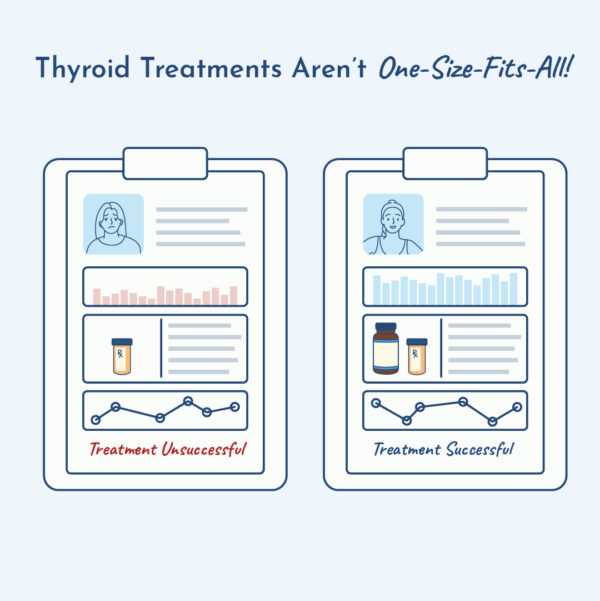
Why You Need To Use T4 and T3 Differently
You may already be aware of the simple differences between T3 and T4. Just in case you’re not…
The important thing to remember is that T4 is the inactive form of thyroid hormone that first must be converted into T3 before your body can use it.
T3, on the other hand, is the active and useable form of thyroid hormone that your body can already use.
However, you may not be aware that T3 and T4 need to be used differently due to how long they are active in your body once they are absorbed.
For example, T4 has a relatively long half-life of a week or longer.
This means that if you took some T4 today, it would continue to work for at least a week or longer before it would leave your body.
When you take T4 daily, it will continue to build up over a week to two week period before it reaches its peak level.
This is why you typically won’t feel the full effects of T4 until after taking it for two or more weeks.
T4’s relatively long half-life is also why you can adjust the dosage, skip a dose, etc., and you typically won’t feel any immediate effect.
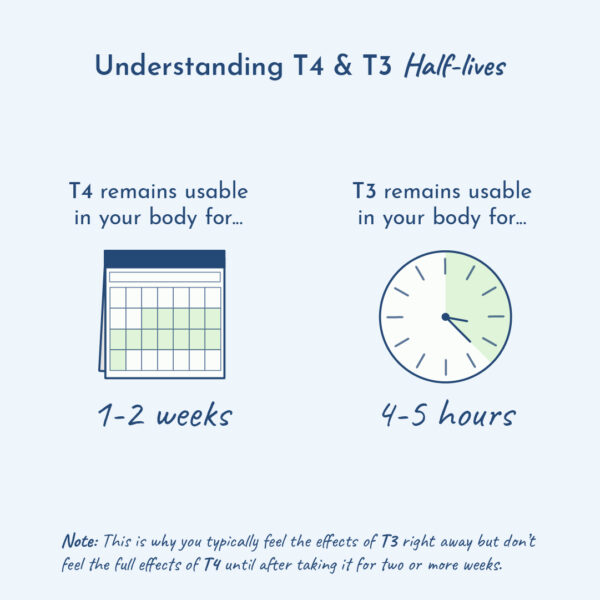
Imagine a bucket full of water with a pin hole sized leak.
Because the water is leaking so slowly and the bucket is full, you don’t have to worry about the bucket running out of water for weeks.
You could just check the water level once a day and add a little water to the bucket when needed without any real worry.
In other words, the half-life of T4 is so long that when used consistently, your T4 level remains relatively stable.
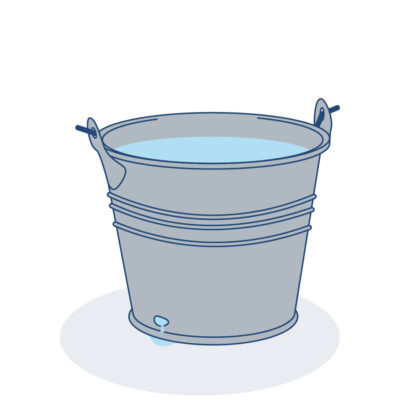
(Note: This is assuming you are not dealing with Hashimoto’s Thyroiditis, which can be a little different.)
This is why many doctors believe that using T4 is safer and easier to manage.
But that’s very poor justification, especially when you can’t convert T4 into T3 or when patients don’t respond favorably to it.
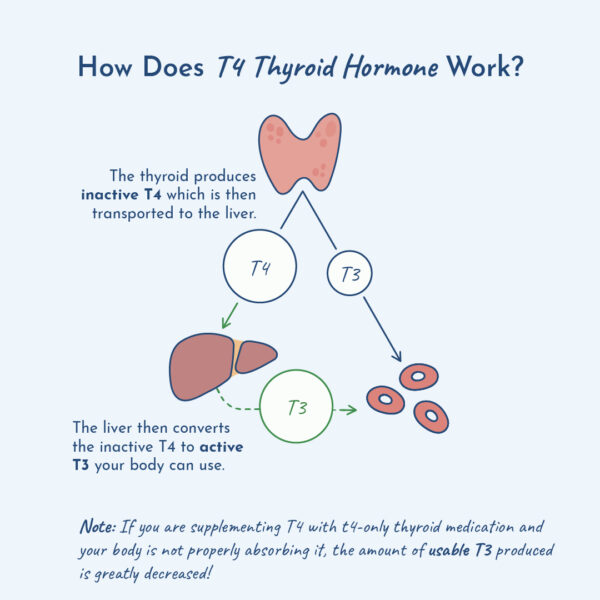
The active form of thyroid hormone T3 is quite a bit different. The half-life of T3 is much shorter. We’re talking about hours, not weeks.
So, when you take T3, it is only active for a relatively short period of time before it leaves your body.
Now, imagine that same bucket full of water but this time with a large hole in it.
Because the water leaks out so fast, it becomes increasingly difficult to keep water in the bucket.
You might have to check the water level every hour or less and keep adding more and more water to make sure the bucket doesn’t run dry.
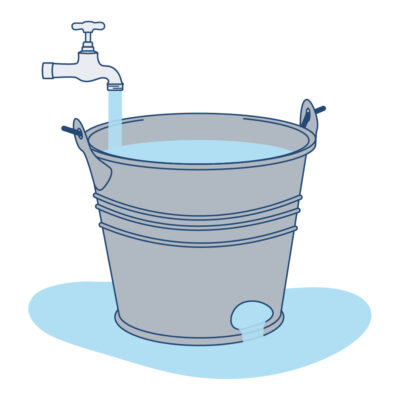
This is why using T3 has to be done with a lot more care. Many doctors don’t understand this difference and wrongly prescribe T3 to be taken in the same manner as T4.
Taking T3 in a larger dose only once per day is like overflowing your bucket and then watching it all leak out shortly thereafter.
The rest of the day you’re left with nothing but an empty bucket and feeling horrible.
Using T3 this way can cause your levels to vary wildly throughout the day, which can be the reason some do not respond favorably.
Oftentimes, this results in feeling marginally better for a few hours, followed by feeling worse again soon after.
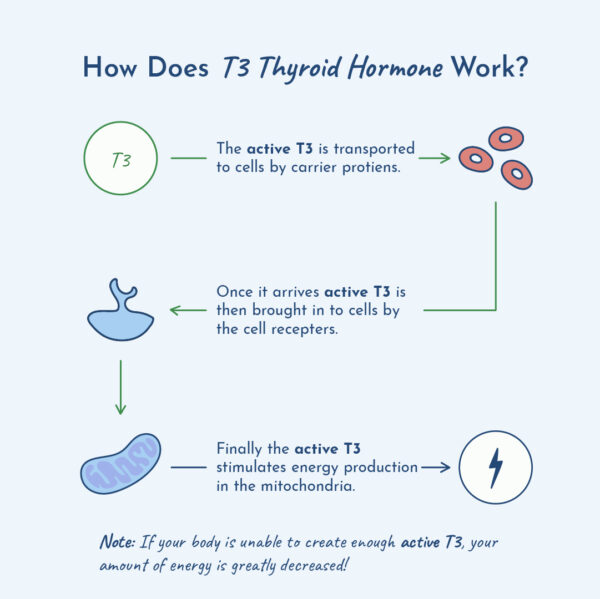
(NOTE: Save 25% and Jump-start Your Thyroid with Raw Desiccated Thyroid. Click here for details.)
3 Simple Rules for Using T3 Safely and Correctly
Many people also feel worse when using thyroid medications and supplements containing T3.
If that’s you, you’re not alone.
This was covered in this previous post as well, but in case you missed it…
For many, using a thyroid medication or supplement containing T3 can cause elevated heart rate, heavy breathing, and feelings of stress and anxiety.
If you’ve ever experienced this then you know exactly what I’m talking about. But the important thing to understand is that just because you can’t tolerate T3 (right now)…
…it doesn’t mean that you don’t need T3 (quite the opposite). Elevated stress hormones are by far the most common cause when it comes to not being able to tolerate T3.
Why?
Because when you become hypothyroid your body compensates by over-activating your stress response.
For many, this means very high levels of adrenaline. And T3 tends to make you much more sensitive to the effects of adrenaline.
In other words, too much T3 will amplify the effects of adrenaline, causing those symptoms of increased heart rate, anxiety, and other high stress symptoms.
I learned this lesson the hard way myself…
Years ago while I was experimenting with small amounts of T3, I was watching a rather intense football game.
I’ll admit it. I can become really enthralled by close games, especially when my team is on the losing end.
Forgetting to take the T3 earlier, I decided to take it right then and there.
Long story short, I had to turn the game off.
My heart was beating out of my chest and the anxiety of simply watching the game reached a whole new level.
Because the half-life of T3 is relatively short, it only lasted for part of the day.
But it goes to show you that even a small amount of T3 can really amplify the effects of adrenaline, when your stress hormones are high.
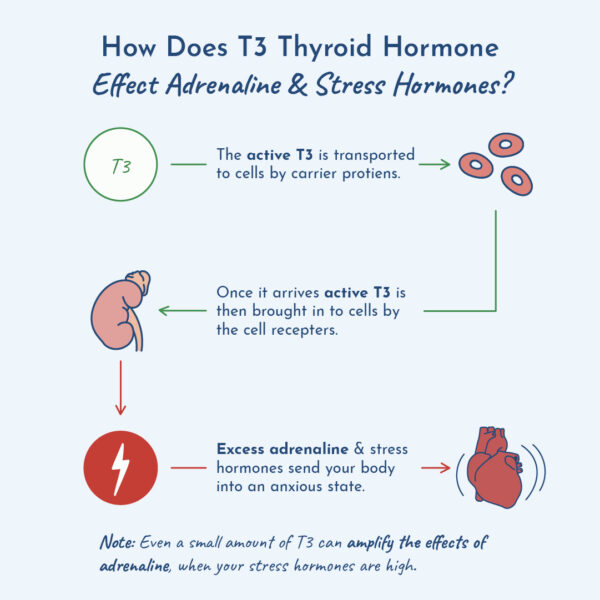

However, it’s important to note that this can cause serious problems in a couple of situations, especially for those with preexisting heart conditions.
If you have a preexisting heart condition, only use T3 under your doctor’s direct care.
With that being said, here are 3 simple ways to use T3 properly and improve your ability to tolerate it…
[Disclaimer… If you are currently using a thyroid medication containing T3 then do not adjust or alter the use of your medication without first consulting with your doctor.]
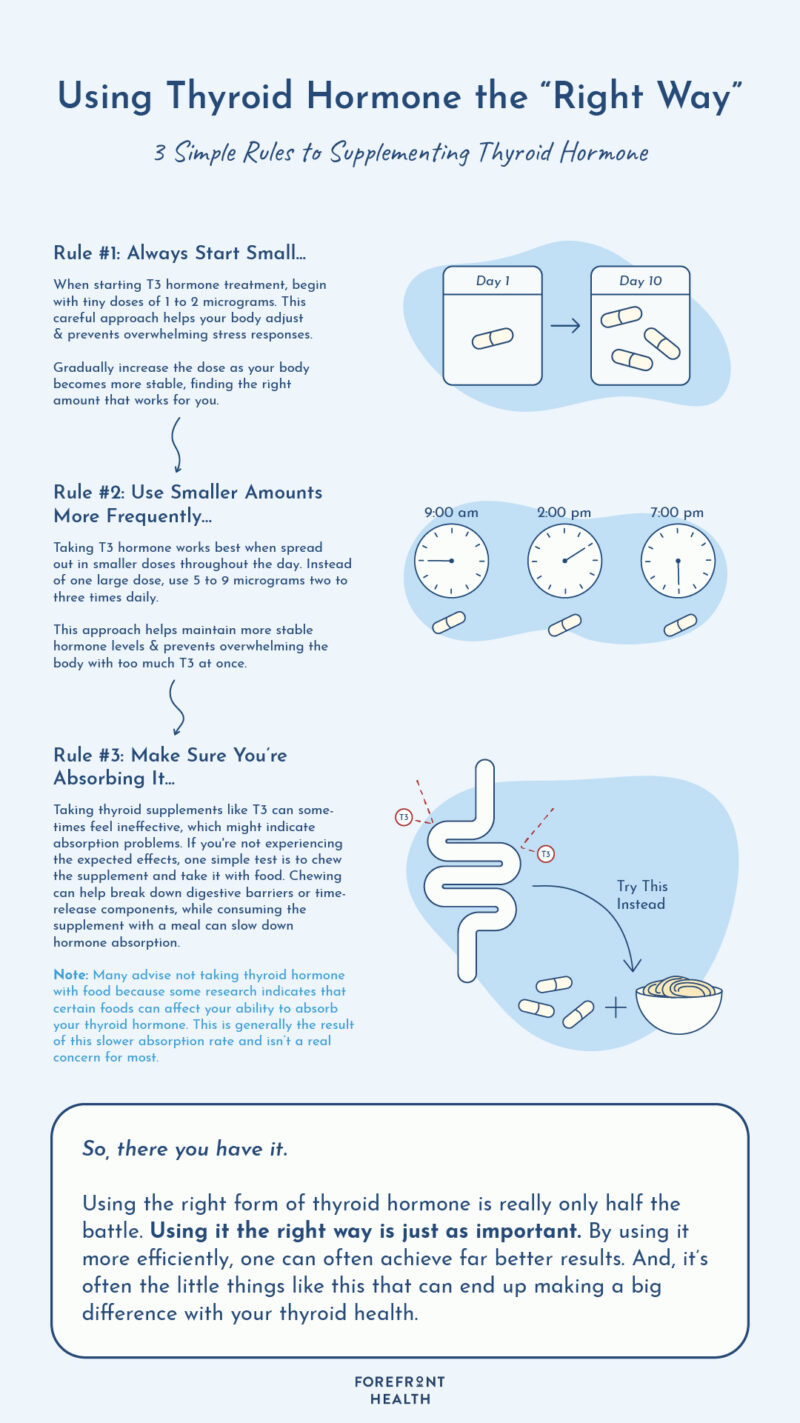

Keep in mind that these rules apply to T3/T4 combination supplements as well since they do contain T3 and the timing of when you use T4 is far less important.
1. Always Start Small…
Anytime you introduce T3, it should be done in very small amounts.
That’s not to say that you don’t need more.
It’s simply a matter of finding how much you can tolerate to start.
T3 is very effective at helping to lower the stress response.
But as mentioned above, if your stress hormones are high, it will amplify their effects.
When introduced properly in small amounts, it can then be increased accordingly as your stress response lowers.
Starting with as little as 1 to 2 micrograms (mcg) may be necessary for some.
Once your stress hormones are under control, you’ll be better able to tolerate the amount of T3 that is right for you.
2. Use Smaller Amounts More Frequently…
Many doctors recommend using T3 just like T4, once a day.
Unless your T3 has a time-release component (which I don’t recommend for reasons mentioned below) then you can absorb too much T3 at one time.
Your thyroid gland produces on the order of 4mcg of T3 per hour.
And I have had some clients who were taking 30mcg or more in a single dose! No wonder they weren’t feeling well on it.
Assuming you have introduced it properly…
Some do best using 5 to 9 mcg two to three times a day or every 4 to 6 hours.
Others with a more active stress response and who are more sensitive may find that 2 to 3 mcg per hour or two is necessary to maintain a more stable T3 level with minimal fluctuations.
3. Make Sure You’re Absorbing It…
If you find that no matter how much T3 you supplement, you just don’t feel any different, it could be related to other underlying hormonal problems that need to be fixed…
…but it can also be an indication that you’re not absorbing it.
I’ve seen this occur with sources of desiccated thyroid like Armour Thyroid as well as thyroid supplements and medications containing a time release component.
One simple way to test this is to chew the supplement and take it with food.
Chewing it can help break down the digestive inhibitors or time-release component, making it much easier to digest.
Taking it with food can help slow down the digestion and absorption of the thyroid hormone so you don’t absorb it too quickly.
If this changes the way you respond to the thyroid hormone, it can indicate a digestion and absorption issue.
(Note: Many advise not taking thyroid hormone with food because some research indicates that certain foods can affect your ability to absorb your thyroid hormone.
This is generally the result of this slower absorption rate and isn’t a real concern for most.
However, if you are concerned then you can do the same on an empty stomach.)
So, there you have it.
Using the right form of thyroid hormone is really only half the battle.
Using it the right way is just as important.
By using it more efficiently, one can often achieve far better results.
And, it’s often the little things like this that can end up making a big difference with your thyroid health.
It’s surely something that has made a difference with our clients.
So, it’s certainly worth experimenting with and finding what works best for you.
You can thank us later.
(NOTE: Save 25% and Jump-start Your Thyroid with Raw Desiccated Thyroid. Click here for details.)
KEY IDEA
Properly using thyroid hormones, especially T3, requires careful management because of its short half-life. Unlike T4, which remains in the body for 1-2 weeks, T3 stays in the body for only a few hours. People with high stress levels may initially struggle with T3 supplementation, experiencing side effects like increased heart rate and anxiety. To improve tolerance, start with smaller doses, taking smaller amounts more frequently throughout the day, & ensuring proper absorption by adjusting how we take it.


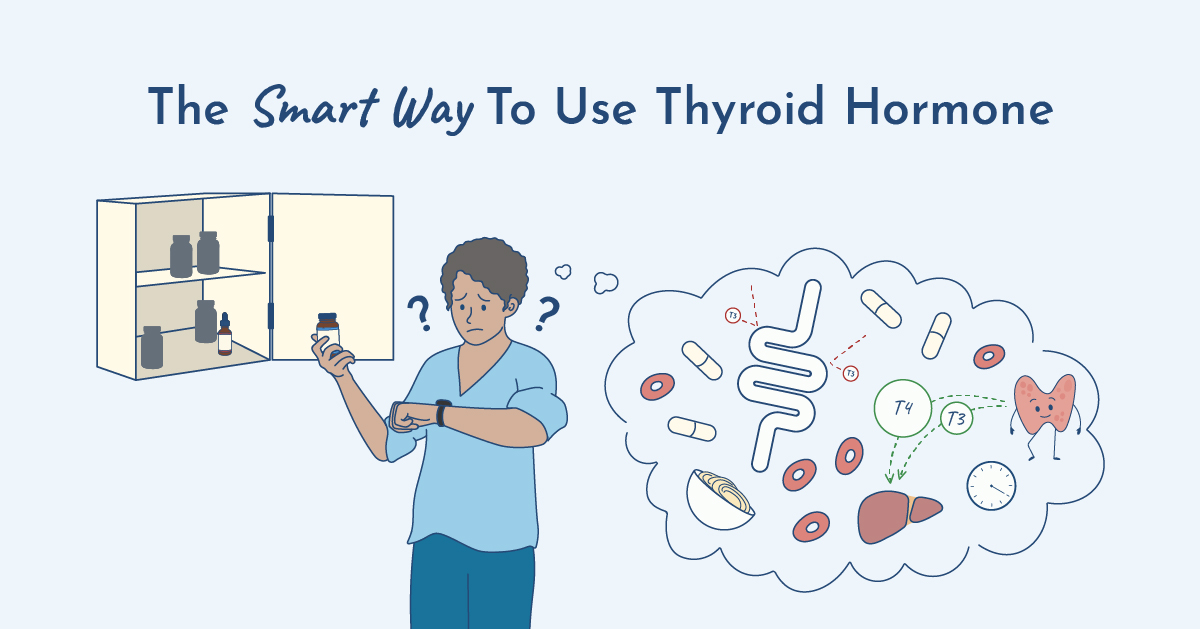

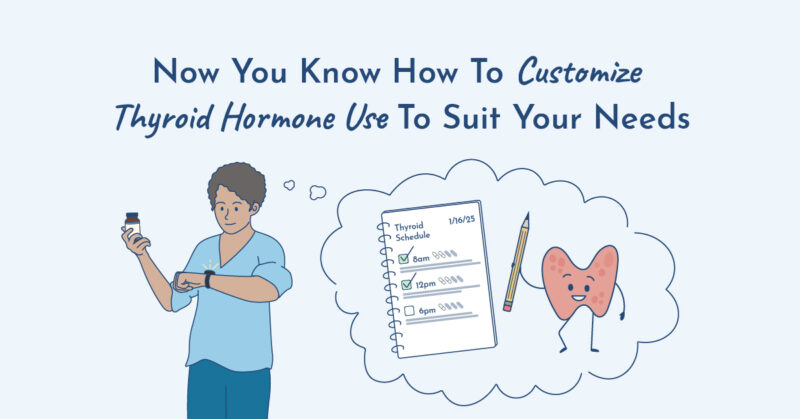




What time of day should I be taking my thyroid medicine? I am on armour
Have you found any evidence that T3 alone can contribute to increasing muscle weakness? I began noticing weakness, particularly in my legs, then spotted some statements regarding such. I have a Reverse T3 dominance issue with Hashimoto’s.
We talk about this in many of our articles… If nutrition isn’t adequate then T3 or anything that simulates metabolism can have opposite effects. If rT3 is elevated then that’s simply a sign of stress.
Elevated stress hormones are very common with hypothyroidism as your body compensated by over-activating the stress response. Poor blood sugar handling will elevate the stress response as well.
Hashimoto’s is largely an issue with estrogen dominance and estrogen is well known for over-activating the stress response from the pituitary level.
There’s a lot involved, not just your thyroid.
Thanks for the response. I’ve been sick since I was 18. Just two years ago, at 45, I finally found a doctor willing to actually listen to me. Even with that, it’s taking a while to get me figured out. We already know I have very low cortisol all day (he checked saliva, blood and urine), Hashi’s and RT3 issues. Will be most likely be rechecking my estrogen since that will have changed since my complete hysterectomy in June. He has me eating a Paleo diet, but, from what I’ve been reading, I think I need more carbs than he recommended.
Do keep in mind that understanding lab tests is very important as well. For example, estrogen accumulates in the tissue, not in the bloodstream so estrogen labs can be quite inaccurate, especially when progesterone is low. And the presence of low cortisol indicates a problem, but you have to understand that the stress response is still very over-active. It’s simply your ability to produce cortisol that is inhibited, likely because of inadequate thyroid/pregnenolone/progesterone.
Good article; but, wish you more success; when you are ready with cell biology and atomic chemistry competence.
God bless you, Mr.Angle of LIFE!
Hi Tom,
I have SIBO and hypothyroidism ( slightly low T-3 free and slightly low total T-3 and on occasion low TSH)
I have tried a multitude of different thyroid medications, and I have shortness of breath with every one. The last medicine was compounded with olive oil , so I could start with just a tiny dose of a couple of drops under my tongue per day. I still developed shortness of breath. I then diluted even more and still had shortness of breath.
What is wrong ?
Thanks,
Gay Jones
At one stage I was taking 20mcg of T3 and would have a blood test the following day, it reflected in my blood tests where T3 was top of range so it was not totally out of my system after 6 hours. No matter what amount of T4 I take it does not convert to higher T3 in bloods, I have to take T3. Since using medication my T3 results are low, especially when taking T4 alone and I am struggling to get them back to pre-diagnosis levels. I am convinced this ugly disease is untreatable, I have tried all the combinations of this and that which have provided me with some fairly impressive TSH results I must say. But I have continued symptoms, am I supposed to ignore this and be happy and unstressed, it is not humanly possible. There are moments whenI feel better then I feel happier, but then it comes back with a vengeance? I am also going broke treating it.
Hi Carolyn, T3 has a half-life in the body so it doesn’t leave the body, only decays. Yet, supplementing T3 (or T4) doesn’t mean your body is actually using it. I would highly recommend you read this:
https://www.forefronthealth.com/overcome-hypothyroidism/
Tom, I have recently begun to drink coffee; one cup in the morning and one cup with noonday meal. It seems to me that I don’t need near as much thyroid hormone now. Is it wise or good to take thyroid hormone at the same time as when taking coffee? Should I take thyroid hormone at other times of the day when I am not drinking coffee?
Does this apply to NatureThroid as well?